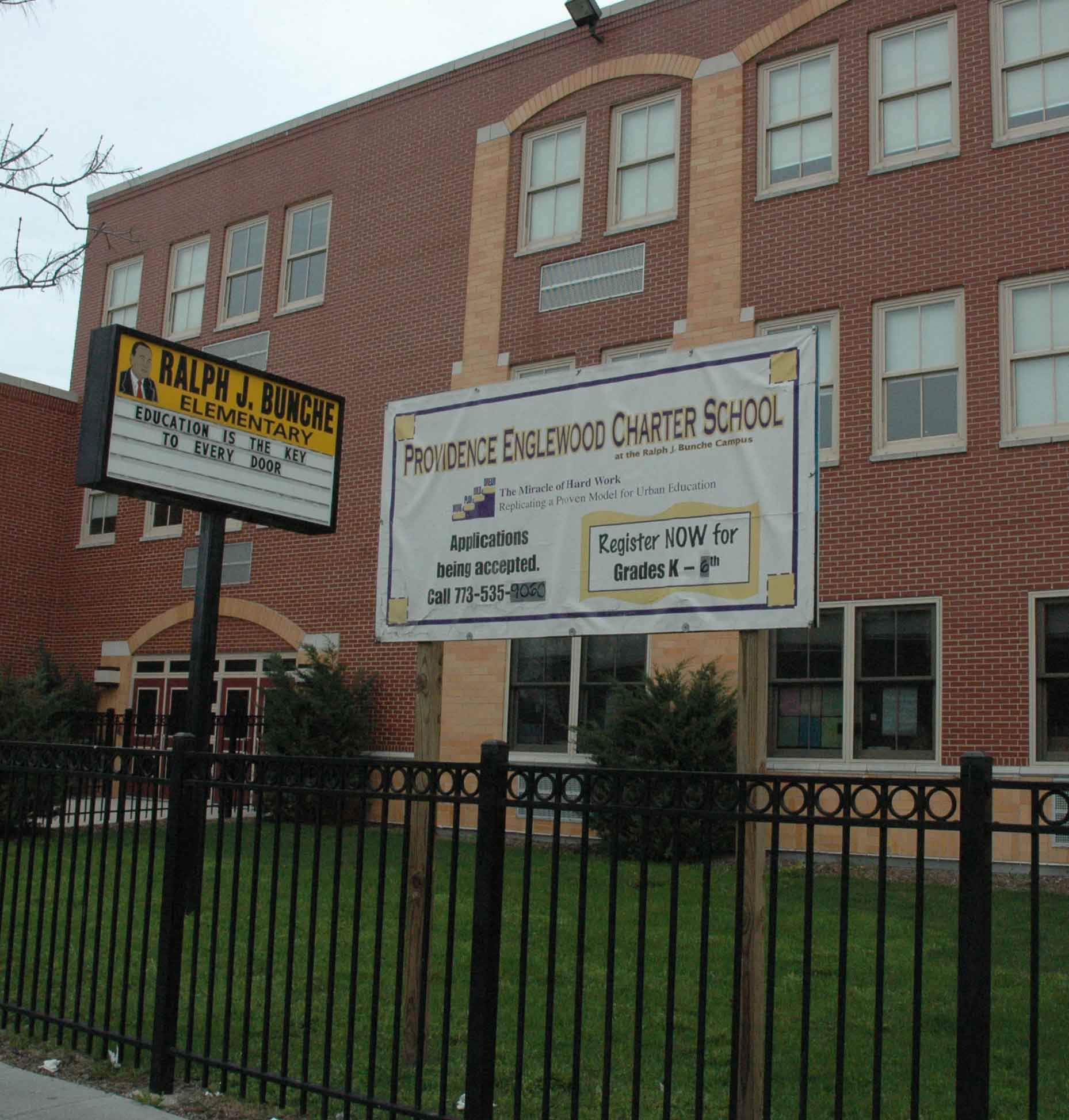Duncan dodges questions August 6th... How much do new schools cost? Who is served by them?
Arne Duncan wants the City of Chicago to believe that the budget woes for the Chicago Public Schools is a problem that exists in Springfield not at 125 S. Clark. I have my doubts. This Substance reporter wanted to get at the costs of Renaissance 2010 as reflected in the budget.
Needless to say, the answers were less than straightforward. The following interview took place during the press conference held on August 6 at CPS headquarters. Duncan had released the proposed budget and announced the budget hearings. In the interview you’ll notice Duncan never addresses the higher administrative costs that charters incur or the other costs of new schools. When Arne Duncan proposed the closing of Ralph Bunche Elementary School at 6515 S. Ashland Ave. (above) in February 2005, the school had 480 students. When the school reopened as the “Providence Englewood Charter School” in September 2006 after being closed a year, it had only 196 students. Yet the cost of administration for the school had increased, even though the majority of children who had attended the school in the past were excluded from the “new” school. Bunche is typical of the charter schools and small schools, which all have enhanced administrative costs while providing seats for fewer and fewer children in their communitiies. Above photo taken by George N. Schmidt for Substance in April 2007.
When Arne Duncan proposed the closing of Ralph Bunche Elementary School at 6515 S. Ashland Ave. (above) in February 2005, the school had 480 students. When the school reopened as the “Providence Englewood Charter School” in September 2006 after being closed a year, it had only 196 students. Yet the cost of administration for the school had increased, even though the majority of children who had attended the school in the past were excluded from the “new” school. Bunche is typical of the charter schools and small schools, which all have enhanced administrative costs while providing seats for fewer and fewer children in their communitiies. Above photo taken by George N. Schmidt for Substance in April 2007.
He will only concede that it’s a “tiny, tiny, tiny percent of the money we spend…“ This is hardly convincing. If you look at CPS statistics, the number of charters has increased from serving 5,535 students in 2000 to 19,420 in 2007 — a more than 350% increase, the number of campuses growing from 14 to 27. That’s a lot of new administration costs. Also, if we look at three old schools in the Englewood community — Englewood High, Bunche Elementary, and Linblom — the number of students as of 2000 was 2,361 students. Now compare the membership numbers in three new schools in the area — Urban Prep, Providence Bunch and Lindblom Math and Science.
According to 2007 data (derived from CPS’s “racial and ethnic survey” online), the number was at 612 students. That’s close to a 390 percent decline in membership. We know these students are being sent to other schools in the attendance boundary, but with all this new money being allocated to these charters, it’s clear that a big chunk of those resources aren’t being spent on the children who would’ve attended the closed schools. Not to mention the more stringent recruiting process the new schools utilize to screen out many of the neighborhood kids. In a nutshell read Arne’s responses with caution, especially the last one, not that as a Substance reader you needed any warning. Substance question: How much have you guys contributed to these numbers problems or money crunch by closing schools and then opening new schools with greater administrative costs. For instance at Englewood High School you now have three “campuses” in the building and three principals — in addition to hiring a campus manager. So that’s four people making six-figure salaries when you used to have one. Where is this money coming from in your budget? Arne Duncan: Obviously you have a philosophical ideological bent there. I think one of the most important things is that we create great new schools for communities that have been underserved. Substance: But how much money is that costing? Duncan: I’ll answer your question. This past fall we’ve actually opened four new great schools in Englewood and we’re proud of that. Students that have been desperately underserved are being much better served today. I will tell you that when public education fails to educate I think we as a public education system perpetuate poverty and perpetuate social failure. We [CPS] refuse to do that. So we opened four great new schools in Englewood last year. Opened the two high schools in the Englewood campus. A tiny tiny tiny percent of the money we spend, I would argue that’s the best investment we make [is] to dramatically improve education Substance: I’ve read that only 11 percent of the students that previously attended traditional schools that are being closed are now being served by the new schools. The Austin the community is clamoring for a new school. Duncan: I think you have your facts wrong. Look at Sherman where not only did every child come back we had an influx of about an additional 100 children who desperately want a better option, who had left that area, traveled to other places and once they had a better option they came home.

